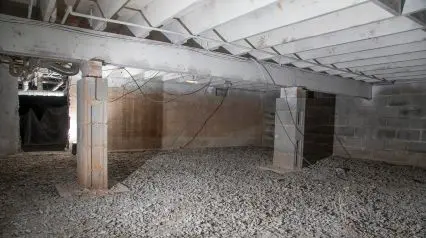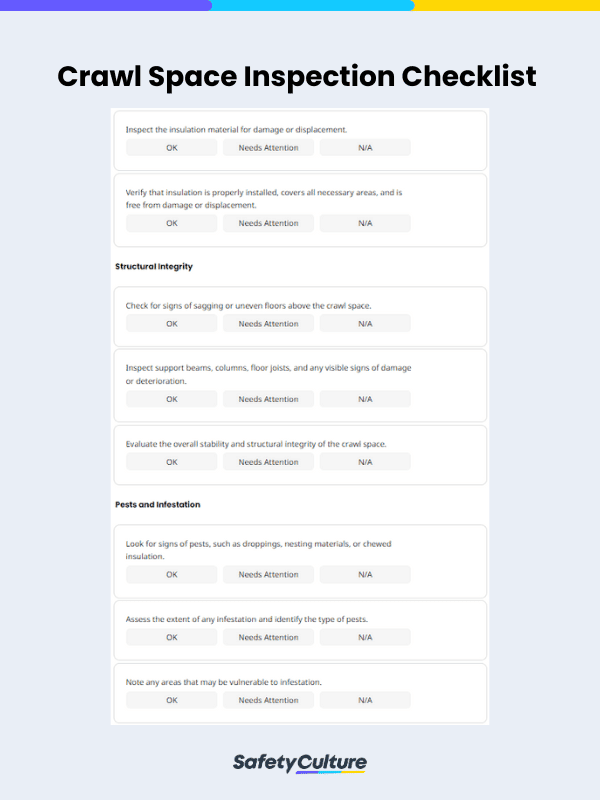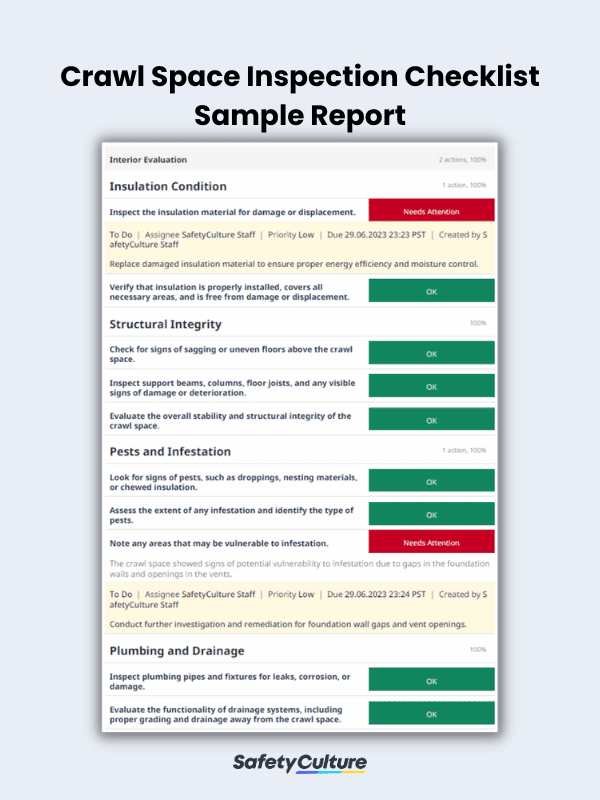What is a Crawl Space Inspection Checklist?
A crawl space inspection checklist is a tool used to systematically assess the condition of a crawl space in a building or property. It consists of a list of items or criteria that need to be evaluated during the inspection to guide inspectors or homeowners in ensuring a comprehensive assessment of the crawl space area to maintain its safety and integrity.
What is the Purpose of a Crawl Space?
Crawl spaces provide access to various utilities and systems within a building, as well as facilitate ventilation and insulation. They are small, shallow areas located between the ground and the first floor of a structure, commonly found in houses with raised foundations or in areas where basements are less common.
Aside from those, the main purposes that crawl spaces serve are the following:
- Access – They provide access to essential components such as plumbing, electrical wiring, HVAC (heating, ventilation, and air conditioning) systems, and other utilities. They allow for easier inspections, maintenance, and repairs of these systems without the need for extensive excavation or access to tight spaces.
- Ventilation – Crawl spaces often have vents or openings that allow air to circulate beneath the building. Proper ventilation helps control moisture levels, prevents the buildup of harmful gases (such as radon), and reduces the risk of mold or mildew growth.
- Insulation – Crawl spaces can be insulated to help regulate temperature and improve energy efficiency. Insulating the walls or floor of a crawl space can prevent heat loss during colder months and minimize heat gain during warmer months, contributing to overall energy savings.
- Structural Support – In some cases, crawl spaces act as a buffer zone between the ground and the living area, offering stability and structural integrity.
- Moisture Control – They also help manage moisture levels which is crucial for preventing issues like mold growth, wood rot, and damage to structural components.
Why Use Checklists When Inspecting Crawl Spaces
It’s important to note that crawl spaces require regular inspection and maintenance to address potential issues or hazards like moisture intrusion, pest infestations, or deteriorating insulation. This way, a well-managed crawl space can help ensure the longevity, safety, and comfort of the building.
To help an expert professional like a crawl space inspector perform in-depth assessments, using inspection checklists is a must to achieve the following benefits:
- Consistency and Efficiency – Inspectors may have different approaches or preferences if they rely solely on memory or experience. By using a checklist, inspections can be performed consistently, ensuring that all necessary aspects are evaluated in the same manner.
- Documentation – Checklists provide a written record of the items inspected, observations made, and any issues identified. This documentation can be useful for reference, future inspections, or when communicating findings with property owners, contractors, or other stakeholders.
- Prioritization – Inspectors can determine which issues require immediate attention and which can be addressed at a later stage to ensure efficient resource allocation and planning for remediation efforts.
What to Include in a Crawl Space Inspection Checklist
While it’s important to customize crawl space inspection checklists to fit specific property requirements and local building codes, here are some key components to consider including aside from the inspection’s title and completion pages:
- Moisture Assessment
- Ventilation Evaluation
- Insulation Condition
- Structural Integrity
- Pests and Infestation
- Plumbing and Drainage
- Electrical Hazards
- Mold or Mildew Growth
- Accessibility and Clearance
- Additional Concerns
How to Create One
Creating a crawl space inspection checklist involves considering the specific requirements and concerns of the property. To guide you, you may follow these steps:
- Begin by identifying the key components of a crawl space that need to be evaluated.
- Ensure that your checklist aligns with local building codes, regulations, and guidelines related to crawl spaces to ensure compliance and address specific concerns in your area.
- Seek advice from experts or professionals with experience in crawl space inspections to gain valuable insights and guidance on what should be included in the checklist based on common issues, best practices, and local considerations.
- Identify potential safety hazards or health risks and include checklist items to evaluate and address them.
- Consider the unique aspects and factors of the property you will be inspecting. This way, you can tailor the checklist to address specific issues that are more likely to arise based on these factors.
- Review and update the checklist periodically to reflect any new information, revised regulations, or lessons learned from previous inspections.
How Do You Inspect a Tight Crawl Space Using a Checklist?
Inspecting a tight crawl space using a checklist requires careful planning and consideration of safety. Here’s a step-by-step guide on how to efficiently check a tight crawl space using a checklist:
- Put on or use appropriate Personal Protective Equipment (PPE) and other safety assets before entering the crawl space. This may include a protective suit or coveralls, gloves, a respirator or mask, and a headlamp for better visibility.
- Evaluate the entry points to the crawl space to ensure they are secure and safe. Clear away debris, obstacles, or loose materials that could hinder access.
- Before entering, scan the crawl space for potential hazards and make sure the area is free from any immediate dangers.
- Assess the accessibility of the crawl space to determine the best entry and exit points. Ensure that there is enough space to move around comfortably and safely.
- Once inside the crawl space, perform a visual assessment of the components listed in the checklist. Use your headlamp to illuminate the area and carefully inspect each item.
- As you inspect, document your findings on the checklist. Note any observations, issues, or areas that require further attention or repairs. Take clear and concise notes to ensure accurate documentation.
- Utilize appropriate tools when assessing hard-to-reach areas and capture visual evidence if needed.
- Once you have assessed all the items on the checklist, review your findings. Make sure all necessary information is documented accurately.
- Exit the crawl space following the same precautions you took when entering. Carefully maneuver out of the tight space, making sure to maintain balance and stability.
- Review your checklist and findings after leaving the crawl space. Prepare a detailed report summarizing the inspection results, including any recommended actions or further investigations.
FAQs About Crawl Space Inspection Checklists
It’s important to choose professionals with relevant expertise and qualifications based on the specific purpose of the crawl space inspection. Depending on the type of building or property and inspection requirements, crawl space inspectors may refer to the following:
- Home inspectors
- Building inspectors
- Pest control specialists
- Structural engineers
- Certified mold inspectors
- HVAC professionals
The frequency of crawl space inspections can vary depending on factors such as the age of the property, location, climate conditions, and any specific concerns or issues previously identified. However, here are some general guidelines or considerations to keep in mind:
- Routine inspections for regular monitoring of the crawl space’s condition
- Seasonal inspections for seasonal concerns such as increased moisture during rainy seasons or extreme temperature fluctuations
- Inspections after significant events including heavy rainfall or flooding, earthquakes, nearby construction activities, or pest infestations
- Inspections prior to property transactions to ensure that any existing issues or potential problems are identified and addressed
- Reactive crawl space maintenance and inspections when signs of problems arise
Yes, it’s highly recommended to consult local building codes and regulations when creating a crawl space inspection checklist. Local building codes provide specific guidelines and requirements that must be followed for the construction, maintenance, and safety of crawl spaces. By referencing and staying on top of these codes, you can ensure that your inspection checklist aligns with legal and regulatory standards in your area.




